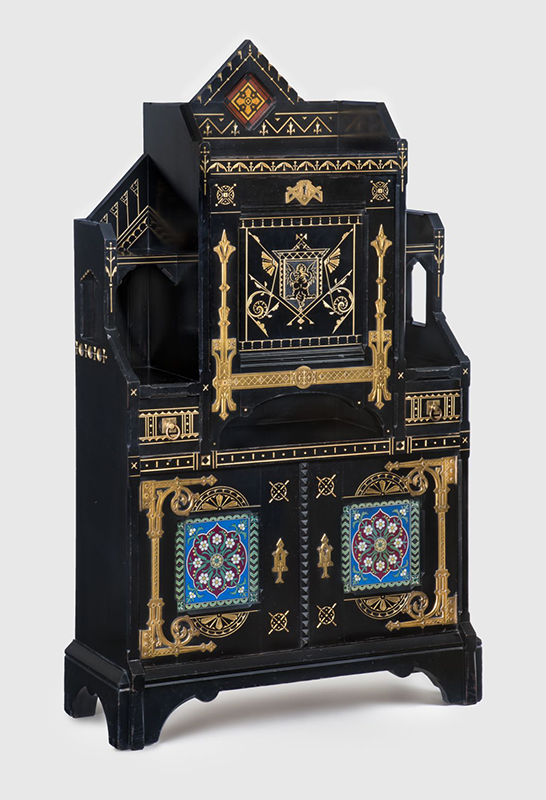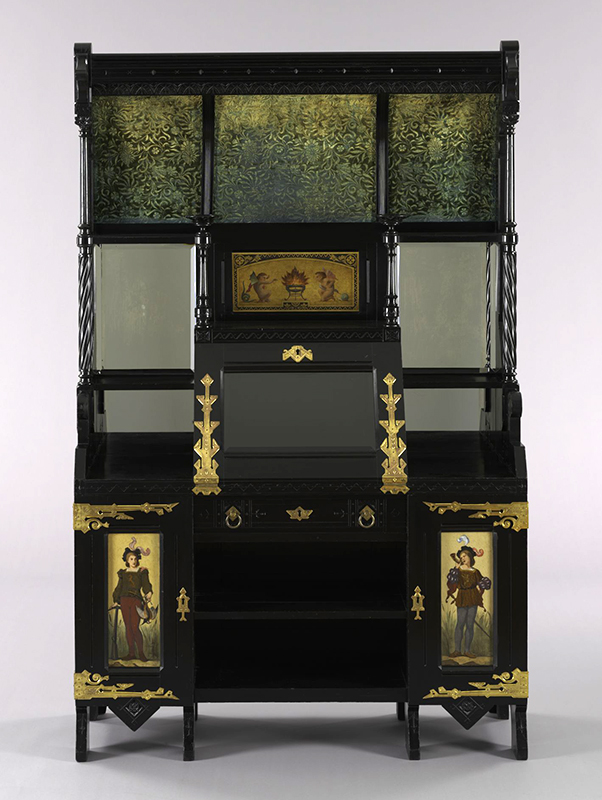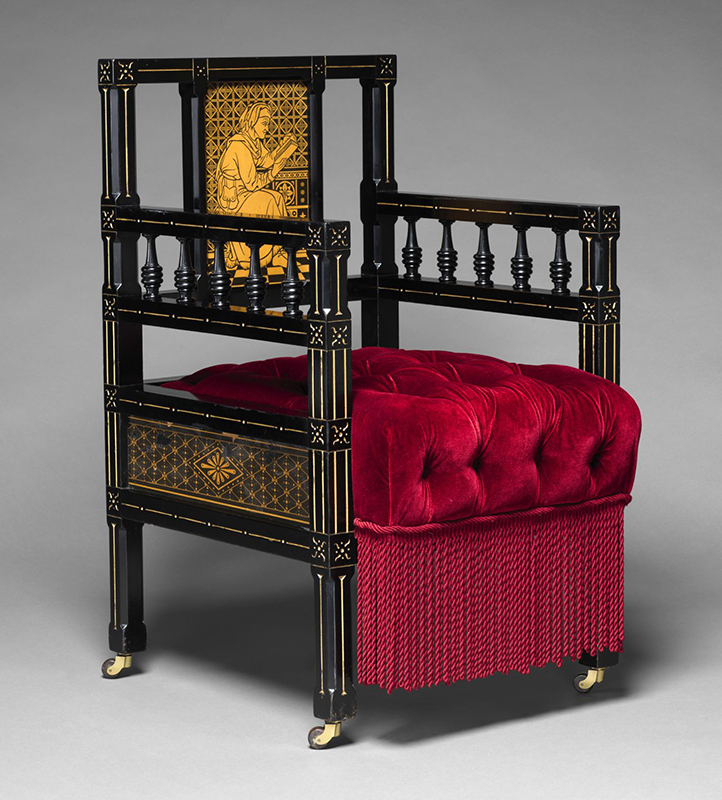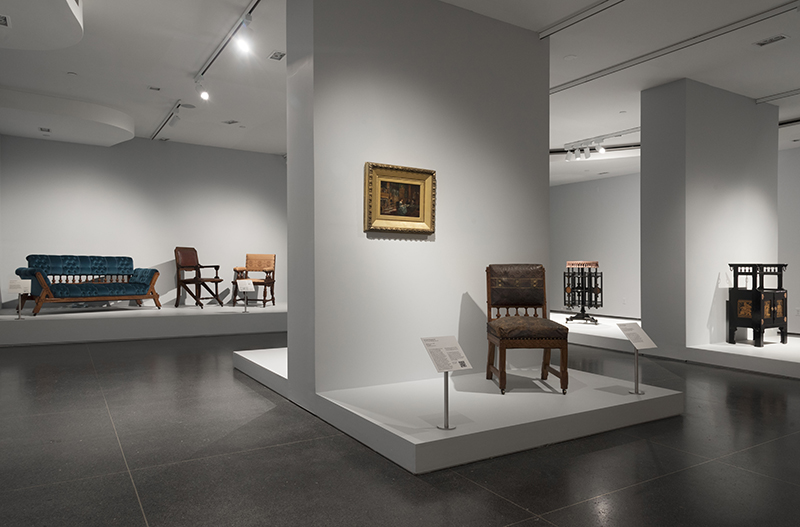Modern Gothic Opens at the Brooklyn Museum
by Matthew Thurlow
Until recently, exhibition openings remained a quaint concept of the bygone pre-COVIDian era. The arrival of an invitation to attend the June 30 opening of the Brooklyn Museum’s Modern Gothic: The Inventive Furniture of Kimbel and Cabus, 1863-82 was therefore cause for great excitement and anticipation. Although attendees donned masks and neither cocktails nor crudité were served, the pleasure of gathering with friends and colleagues in celebration of this show, and the catalogue that accompanies it, provided much-relished confidence in museums’ post-pandemic existence.
Organized in homage to the late Barry Harwood, a heralded curator of decorative arts at the Brooklyn Museum and an influential mentor for innumerable colleagues in the field, Barbara Veith picked up the mantle of what was to be Barry’s last exhibition. Stepping in as guest curator, Veith retained the institution’s commitment to the project as well as Deedee and Barrie Wigmore’s leadership support of the exhibition and publication, the latter co-authored with Medill Higgins Harvey, the Ruth Bigelow Wriston Associate Curator of American Decorative Arts at The Met, who also fell under Barry’s tutelage.
Anton Kimbel (1822-1895) and Joseph Cabus (1824-1898) were seasoned cabinetmaking professionals when they hung a shingle on New York City’s Broadway in 1863. Veith and Harvey interpret the partnership of Kimbel, from Mainz, Germany, and Cabus, from Calmouier, France, as a “timeless immigrant success story.” Although Kimbel and Cabus entered business at the depth of the Civil War in a city marred by unrest and violence, they operated in an auspicious era of tremendous creativity and innovation in the New York furniture trade. With the Herter Brothers serving as a primary competitor throughout the 1860s and 1870s, both firms achieved notoriety through illustrated advertising and the industrial fairs that captured international interest.
To clarify for our readers, the Modern Gothic aesthetic is a distant cousin to the Gothic Revival style that appeared earlier in the 19th century. Although both phases were established abroad under a progressive intent to reform design and manufacture, the former was championed by English architects and designers Bruce James Talbert (1838-1881) and Charles Locke Eastlake (1836-1906) in what would later become known as the Aesthetic Movement.
Under the talented oversight of Kimbel and Cabus, the Modern Gothic was manipulated with aplomb through a variety of materials, motifs, and methods. Picture a Gilded Age interior, where Kimbel and Cabus’s furniture would feel at ease, and you can imagine the level of detail typical of the firm’s best work. The cabinetmakers’ inventiveness led them to repurpose forms and designs to create variety. A desk or cabinet offered in black walnut could achieve a new look in ebonized cherry, both with ample space for the display of ceramics or other small objects. A hanging cabinet in oak with nickel hardware was revised in rosewood with brass hardware. And as one might expect of seating furniture destined for such enriched spaces, customers could select from a variety of upholstery, ranging from tufted velvets replete with long fringe to gilt-decorated leather.
Kimbel and Cabus, Desk and Display Cabinet, c. 1876, New York, NY. Ebonized cherry, gilding, polychrome, silver, mirrored mercury-tin amalgam and clear glass, velvet, brass. The Baltimore Museum of Art; The Richard C. von Hess Foundation Acquisition Fund; partial gift of Michael and Anis Merson; and purchase with exchange funds from Bequest of Margaret Anna Abell; Bequest of Eleanor M. Anderson; Bequest of Alice Worthington Ball; Decorative Arts Fund; Gift of Elizabeth S. Ellis, from the Estate of Margaret Anna Abell; Gift of William Bose Marye; Bequest of Margaret D. Morriss; Gift of Abram Moses, in Memory of his Wife, Carrie Gutman Moses; Gift of Mrs. John W. Nicol, Jr.; Gift of Merrell L. Stout, Jr., in Memory of his Father, Dr. Merrell L. Stout, BMA 1999.150. Photo by Mitro Hood.
The firm’s “artistic” furniture occasionally features colorful earthenware tiles and hand-painted plaques inserted to add decorative interest and establish a Gothic or Middle Eastern sensibility. Kimbel and Cabus also used a less expensive printed-paper substitute to impressive effect in cabinets and desks as well as seating furniture. For example, the obverse and reverse sides of an armchair’s back splat feature opposed paper panels depicting Wisdom and Folly, derived from Medieval-style designs by British artist Charles Rossiter (1827-1897).
The exhibition is notable for the range of Kimbel and Cabus’s work on display as well as its extensive scale and airy design. Veith resisted the temptation to pack this rich, colorful, and textured material into dense groupings, choosing instead to present the material in a long sequence of spaces that combine the firm’s signature furniture forms with reproductions of archival materials that contextualize the late-19th-century milieu in which Kimbel and Cabus operated. The aesthetic sensibility of the movement is reinforced through vignettes depicting the layered ornamentation of Modern Gothic interiors.
The hardcover catalogue is available through the Brooklyn Museum. The beautifully illustrated 208-page publication is co-authored by Veith and Harvey with additional contributions by Max Donnelly, Curator of Nineteenth-Century Furniture, Victoria and Albert Museum, on the English origins of the Modern Gothic; Alice Cooney Frelinghuysen, Anthony W. and Lulu C. Wang Curator of American Decorative Arts, Metropolitan Museum of Art, on Kimbel and Cabus’s position within the late-19th-century New York furniture trade; and Dr. Melitta Jonas, art historian, Berlin, on the Kimbel family’s origins in Mainz. Our curatorial and academic friends will likely long for an index, but this volume is a valuable addition to the library nonetheless.
Matthew Thurlow is the Executive Director of the Decorative Arts Trust.
About The Decorative Arts Trust Bulletin
Formerly known as the "blog,” the Bulletin features new research and scholarship, travelogues, book reviews, and museum and gallery exhibitions. The Bulletin complements The Magazine of the Decorative Arts Trust, our biannual members publication.












